BSBMGT407: Applying Digital Solutions to Work Processes - Task 3
VerifiedAdded on 2023/05/30
|8
|1700
|117
Homework Assignment
AI Summary
This assignment focuses on applying digital solutions to work processes within an organization, specifically addressing intellectual property and compliance. It includes scenario-based questions that require evaluating digital technology options, understanding the impact of legislation and organizational policies, and identifying relevant intellectual property regulations. The assignment also involves creating a risk register to document potential intellectual property risks and implementing controls to mitigate them, such as registering trademarks, patents, and copyrights. The chosen digital process for this study is the implementation of a workflow management system that automates time tracking, tasks tracking, issues tracking and project management.
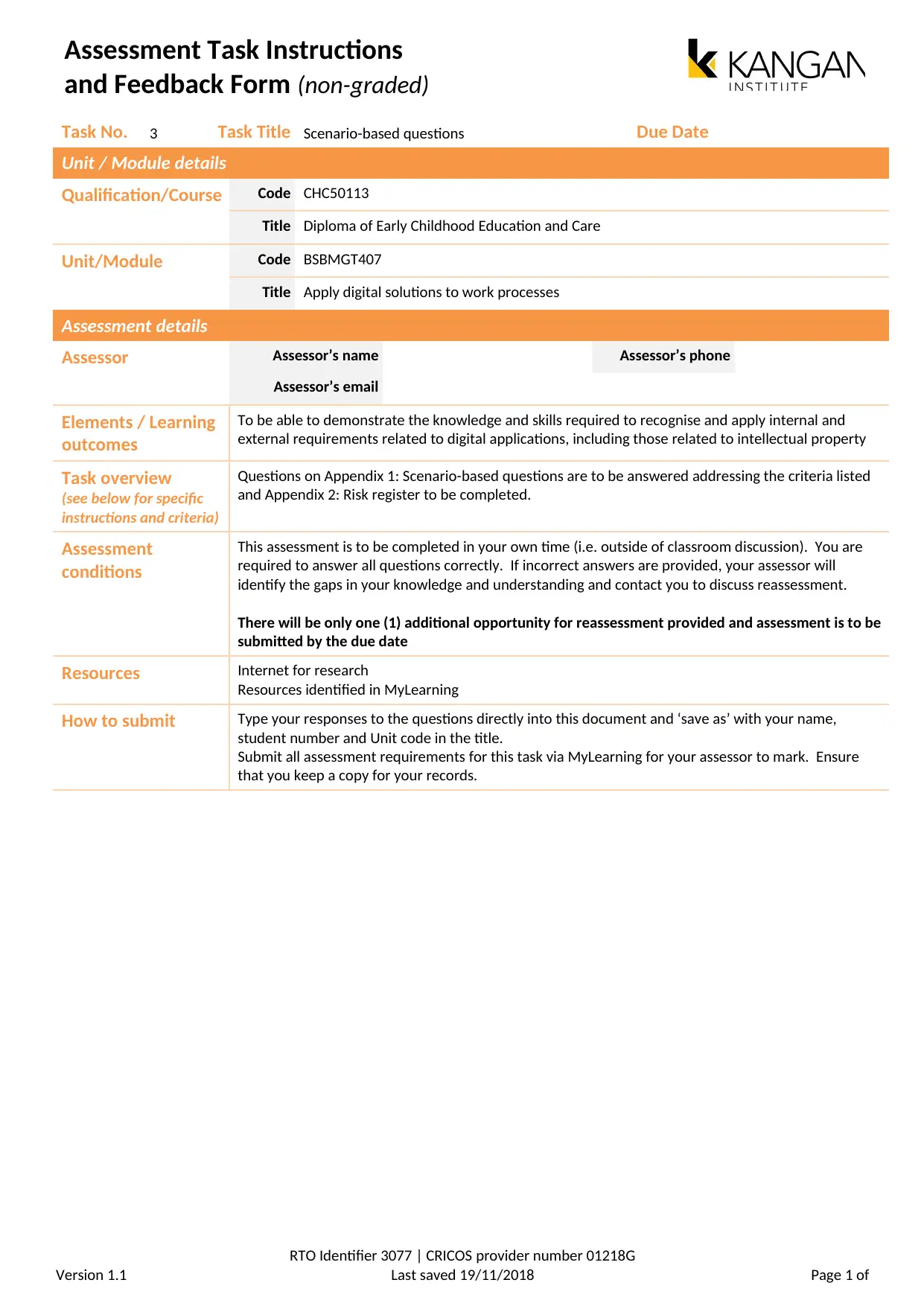
Assessment Task Instructions
and Feedback Form (non-graded)
Task No. 3 Task Title Scenario-based questions Due Date
Unit / Module details
Qualification/Course Code CHC50113
Title Diploma of Early Childhood Education and Care
Unit/Module Code BSBMGT407
Title Apply digital solutions to work processes
Assessment details
Assessor Assessor’s name Assessor’s phone
Assessor’s email
Elements / Learning
outcomes
To be able to demonstrate the knowledge and skills required to recognise and apply internal and
external requirements related to digital applications, including those related to intellectual property
Task overview
(see below for specific
instructions and criteria)
Questions on Appendix 1: Scenario-based questions are to be answered addressing the criteria listed
and Appendix 2: Risk register to be completed.
Assessment
conditions
This assessment is to be completed in your own time (i.e. outside of classroom discussion). You are
required to answer all questions correctly. If incorrect answers are provided, your assessor will
identify the gaps in your knowledge and understanding and contact you to discuss reassessment.
There will be only one (1) additional opportunity for reassessment provided and assessment is to be
submitted by the due date
Resources Internet for research
Resources identified in MyLearning
How to submit Type your responses to the questions directly into this document and ‘save as’ with your name,
student number and Unit code in the title.
Submit all assessment requirements for this task via MyLearning for your assessor to mark. Ensure
that you keep a copy for your records.
RTO Identifier 3077 | CRICOS provider number 01218G
Version 1.1 Last saved 19/11/2018 Page 1 of
and Feedback Form (non-graded)
Task No. 3 Task Title Scenario-based questions Due Date
Unit / Module details
Qualification/Course Code CHC50113
Title Diploma of Early Childhood Education and Care
Unit/Module Code BSBMGT407
Title Apply digital solutions to work processes
Assessment details
Assessor Assessor’s name Assessor’s phone
Assessor’s email
Elements / Learning
outcomes
To be able to demonstrate the knowledge and skills required to recognise and apply internal and
external requirements related to digital applications, including those related to intellectual property
Task overview
(see below for specific
instructions and criteria)
Questions on Appendix 1: Scenario-based questions are to be answered addressing the criteria listed
and Appendix 2: Risk register to be completed.
Assessment
conditions
This assessment is to be completed in your own time (i.e. outside of classroom discussion). You are
required to answer all questions correctly. If incorrect answers are provided, your assessor will
identify the gaps in your knowledge and understanding and contact you to discuss reassessment.
There will be only one (1) additional opportunity for reassessment provided and assessment is to be
submitted by the due date
Resources Internet for research
Resources identified in MyLearning
How to submit Type your responses to the questions directly into this document and ‘save as’ with your name,
student number and Unit code in the title.
Submit all assessment requirements for this task via MyLearning for your assessor to mark. Ensure
that you keep a copy for your records.
RTO Identifier 3077 | CRICOS provider number 01218G
Version 1.1 Last saved 19/11/2018 Page 1 of
Paraphrase This Document
Need a fresh take? Get an instant paraphrase of this document with our AI Paraphraser
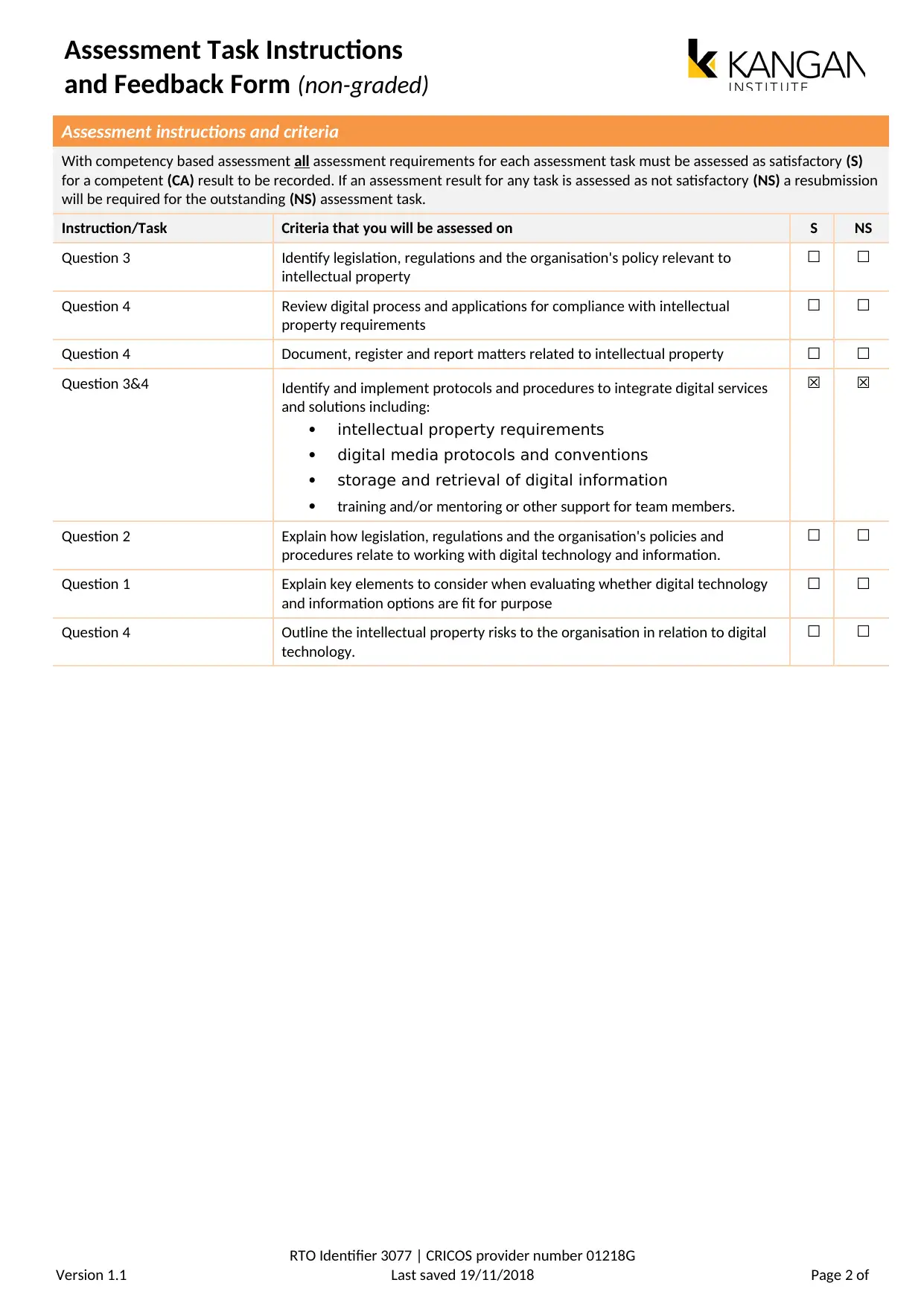
Assessment Task Instructions
and Feedback Form (non-graded)
Assessment instructions and criteria
With competency based assessment all assessment requirements for each assessment task must be assessed as satisfactory (S)
for a competent (CA) result to be recorded. If an assessment result for any task is assessed as not satisfactory (NS) a resubmission
will be required for the outstanding (NS) assessment task.
Instruction/Task Criteria that you will be assessed on S NS
Question 3 Identify legislation, regulations and the organisation's policy relevant to
intellectual property
☐ ☐
Question 4 Review digital process and applications for compliance with intellectual
property requirements
☐ ☐
Question 4 Document, register and report matters related to intellectual property ☐ ☐
Question 3&4 Identify and implement protocols and procedures to integrate digital services
and solutions including:
intellectual property requirements
digital media protocols and conventions
storage and retrieval of digital information
training and/or mentoring or other support for team members.
☒ ☒
Question 2 Explain how legislation, regulations and the organisation's policies and
procedures relate to working with digital technology and information.
☐ ☐
Question 1 Explain key elements to consider when evaluating whether digital technology
and information options are fit for purpose
☐ ☐
Question 4 Outline the intellectual property risks to the organisation in relation to digital
technology.
☐ ☐
RTO Identifier 3077 | CRICOS provider number 01218G
Version 1.1 Last saved 19/11/2018 Page 2 of
and Feedback Form (non-graded)
Assessment instructions and criteria
With competency based assessment all assessment requirements for each assessment task must be assessed as satisfactory (S)
for a competent (CA) result to be recorded. If an assessment result for any task is assessed as not satisfactory (NS) a resubmission
will be required for the outstanding (NS) assessment task.
Instruction/Task Criteria that you will be assessed on S NS
Question 3 Identify legislation, regulations and the organisation's policy relevant to
intellectual property
☐ ☐
Question 4 Review digital process and applications for compliance with intellectual
property requirements
☐ ☐
Question 4 Document, register and report matters related to intellectual property ☐ ☐
Question 3&4 Identify and implement protocols and procedures to integrate digital services
and solutions including:
intellectual property requirements
digital media protocols and conventions
storage and retrieval of digital information
training and/or mentoring or other support for team members.
☒ ☒
Question 2 Explain how legislation, regulations and the organisation's policies and
procedures relate to working with digital technology and information.
☐ ☐
Question 1 Explain key elements to consider when evaluating whether digital technology
and information options are fit for purpose
☐ ☐
Question 4 Outline the intellectual property risks to the organisation in relation to digital
technology.
☐ ☐
RTO Identifier 3077 | CRICOS provider number 01218G
Version 1.1 Last saved 19/11/2018 Page 2 of
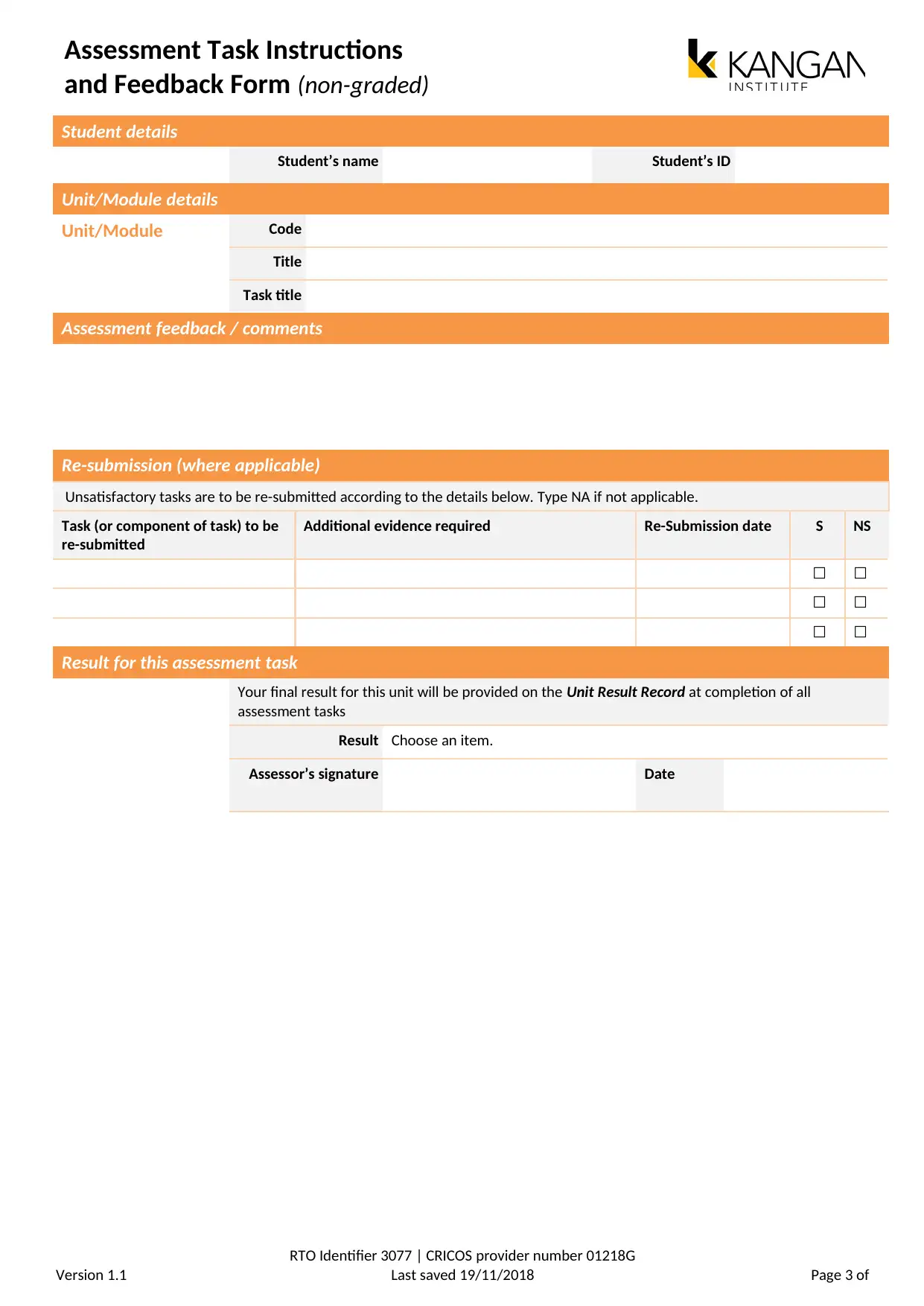
Assessment Task Instructions
and Feedback Form (non-graded)
Student details
Student’s name Student’s ID
Unit/Module details
Unit/Module Code
Title
Task title
Assessment feedback / comments
Re-submission (where applicable)
Unsatisfactory tasks are to be re-submitted according to the details below. Type NA if not applicable.
Task (or component of task) to be
re-submitted
Additional evidence required Re-Submission date S NS
☐ ☐
☐ ☐
☐ ☐
Result for this assessment task
Your final result for this unit will be provided on the Unit Result Record at completion of all
assessment tasks
Result Choose an item.
Assessor’s signature Date
RTO Identifier 3077 | CRICOS provider number 01218G
Version 1.1 Last saved 19/11/2018 Page 3 of
and Feedback Form (non-graded)
Student details
Student’s name Student’s ID
Unit/Module details
Unit/Module Code
Title
Task title
Assessment feedback / comments
Re-submission (where applicable)
Unsatisfactory tasks are to be re-submitted according to the details below. Type NA if not applicable.
Task (or component of task) to be
re-submitted
Additional evidence required Re-Submission date S NS
☐ ☐
☐ ☐
☐ ☐
Result for this assessment task
Your final result for this unit will be provided on the Unit Result Record at completion of all
assessment tasks
Result Choose an item.
Assessor’s signature Date
RTO Identifier 3077 | CRICOS provider number 01218G
Version 1.1 Last saved 19/11/2018 Page 3 of
⊘ This is a preview!⊘
Do you want full access?
Subscribe today to unlock all pages.

Trusted by 1+ million students worldwide
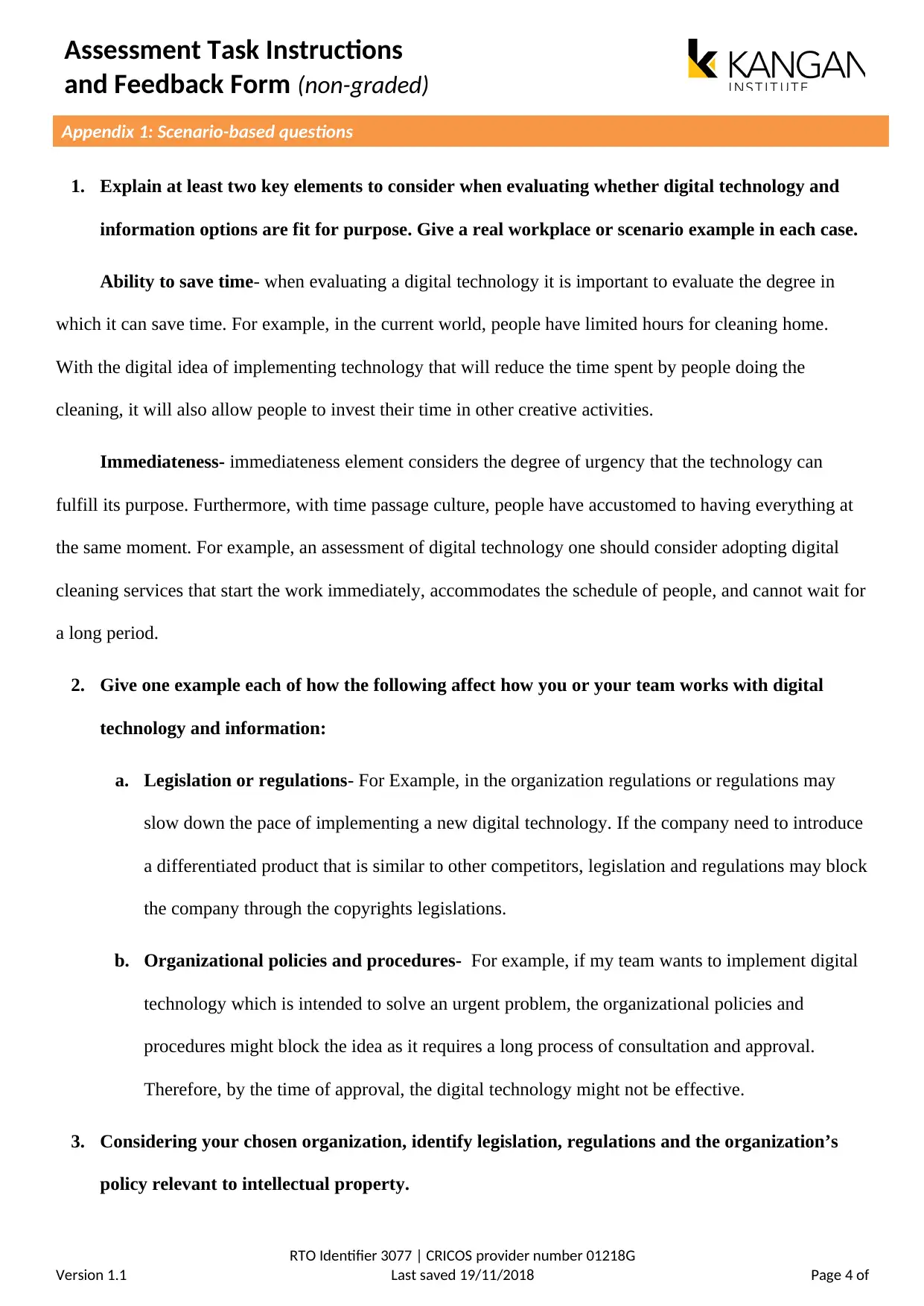
Assessment Task Instructions
and Feedback Form (non-graded)
Appendix 1: Scenario-based questions
1. Explain at least two key elements to consider when evaluating whether digital technology and
information options are fit for purpose. Give a real workplace or scenario example in each case.
Ability to save time- when evaluating a digital technology it is important to evaluate the degree in
which it can save time. For example, in the current world, people have limited hours for cleaning home.
With the digital idea of implementing technology that will reduce the time spent by people doing the
cleaning, it will also allow people to invest their time in other creative activities.
Immediateness- immediateness element considers the degree of urgency that the technology can
fulfill its purpose. Furthermore, with time passage culture, people have accustomed to having everything at
the same moment. For example, an assessment of digital technology one should consider adopting digital
cleaning services that start the work immediately, accommodates the schedule of people, and cannot wait for
a long period.
2. Give one example each of how the following affect how you or your team works with digital
technology and information:
a. Legislation or regulations- For Example, in the organization regulations or regulations may
slow down the pace of implementing a new digital technology. If the company need to introduce
a differentiated product that is similar to other competitors, legislation and regulations may block
the company through the copyrights legislations.
b. Organizational policies and procedures- For example, if my team wants to implement digital
technology which is intended to solve an urgent problem, the organizational policies and
procedures might block the idea as it requires a long process of consultation and approval.
Therefore, by the time of approval, the digital technology might not be effective.
3. Considering your chosen organization, identify legislation, regulations and the organization’s
policy relevant to intellectual property.
RTO Identifier 3077 | CRICOS provider number 01218G
Version 1.1 Last saved 19/11/2018 Page 4 of
and Feedback Form (non-graded)
Appendix 1: Scenario-based questions
1. Explain at least two key elements to consider when evaluating whether digital technology and
information options are fit for purpose. Give a real workplace or scenario example in each case.
Ability to save time- when evaluating a digital technology it is important to evaluate the degree in
which it can save time. For example, in the current world, people have limited hours for cleaning home.
With the digital idea of implementing technology that will reduce the time spent by people doing the
cleaning, it will also allow people to invest their time in other creative activities.
Immediateness- immediateness element considers the degree of urgency that the technology can
fulfill its purpose. Furthermore, with time passage culture, people have accustomed to having everything at
the same moment. For example, an assessment of digital technology one should consider adopting digital
cleaning services that start the work immediately, accommodates the schedule of people, and cannot wait for
a long period.
2. Give one example each of how the following affect how you or your team works with digital
technology and information:
a. Legislation or regulations- For Example, in the organization regulations or regulations may
slow down the pace of implementing a new digital technology. If the company need to introduce
a differentiated product that is similar to other competitors, legislation and regulations may block
the company through the copyrights legislations.
b. Organizational policies and procedures- For example, if my team wants to implement digital
technology which is intended to solve an urgent problem, the organizational policies and
procedures might block the idea as it requires a long process of consultation and approval.
Therefore, by the time of approval, the digital technology might not be effective.
3. Considering your chosen organization, identify legislation, regulations and the organization’s
policy relevant to intellectual property.
RTO Identifier 3077 | CRICOS provider number 01218G
Version 1.1 Last saved 19/11/2018 Page 4 of
Paraphrase This Document
Need a fresh take? Get an instant paraphrase of this document with our AI Paraphraser
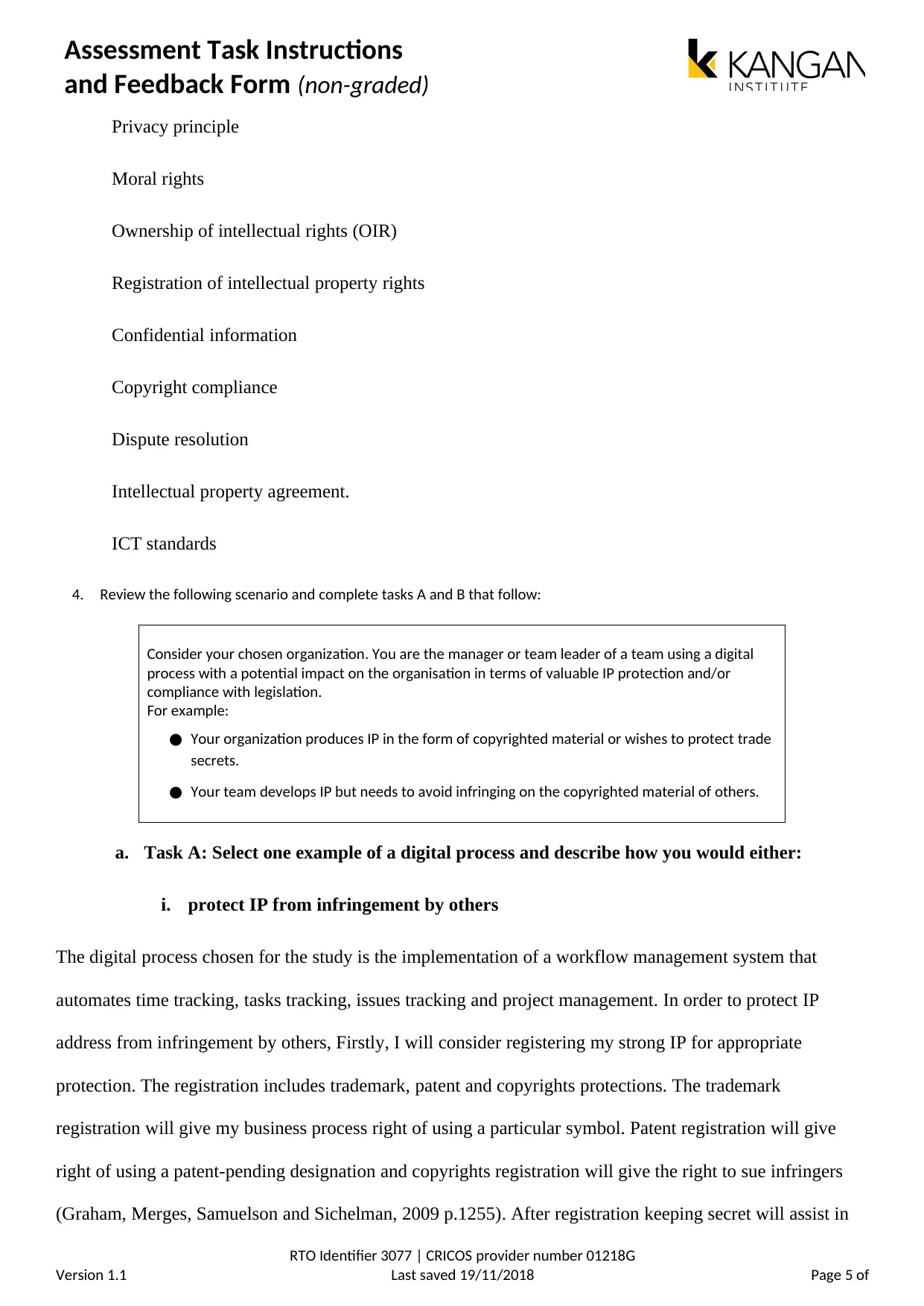
Assessment Task Instructions
and Feedback Form (non-graded)
Privacy principle
Moral rights
Ownership of intellectual rights (OIR)
Registration of intellectual property rights
Confidential information
Copyright compliance
Dispute resolution
Intellectual property agreement.
ICT standards
4. Review the following scenario and complete tasks A and B that follow:
Consider your chosen organization. You are the manager or team leader of a team using a digital
process with a potential impact on the organisation in terms of valuable IP protection and/or
compliance with legislation.
For example:
● Your organization produces IP in the form of copyrighted material or wishes to protect trade
secrets.
● Your team develops IP but needs to avoid infringing on the copyrighted material of others.
a. Task A: Select one example of a digital process and describe how you would either:
i. protect IP from infringement by others
The digital process chosen for the study is the implementation of a workflow management system that
automates time tracking, tasks tracking, issues tracking and project management. In order to protect IP
address from infringement by others, Firstly, I will consider registering my strong IP for appropriate
protection. The registration includes trademark, patent and copyrights protections. The trademark
registration will give my business process right of using a particular symbol. Patent registration will give
right of using a patent-pending designation and copyrights registration will give the right to sue infringers
(Graham, Merges, Samuelson and Sichelman, 2009 p.1255). After registration keeping secret will assist in
RTO Identifier 3077 | CRICOS provider number 01218G
Version 1.1 Last saved 19/11/2018 Page 5 of
and Feedback Form (non-graded)
Privacy principle
Moral rights
Ownership of intellectual rights (OIR)
Registration of intellectual property rights
Confidential information
Copyright compliance
Dispute resolution
Intellectual property agreement.
ICT standards
4. Review the following scenario and complete tasks A and B that follow:
Consider your chosen organization. You are the manager or team leader of a team using a digital
process with a potential impact on the organisation in terms of valuable IP protection and/or
compliance with legislation.
For example:
● Your organization produces IP in the form of copyrighted material or wishes to protect trade
secrets.
● Your team develops IP but needs to avoid infringing on the copyrighted material of others.
a. Task A: Select one example of a digital process and describe how you would either:
i. protect IP from infringement by others
The digital process chosen for the study is the implementation of a workflow management system that
automates time tracking, tasks tracking, issues tracking and project management. In order to protect IP
address from infringement by others, Firstly, I will consider registering my strong IP for appropriate
protection. The registration includes trademark, patent and copyrights protections. The trademark
registration will give my business process right of using a particular symbol. Patent registration will give
right of using a patent-pending designation and copyrights registration will give the right to sue infringers
(Graham, Merges, Samuelson and Sichelman, 2009 p.1255). After registration keeping secret will assist in
RTO Identifier 3077 | CRICOS provider number 01218G
Version 1.1 Last saved 19/11/2018 Page 5 of
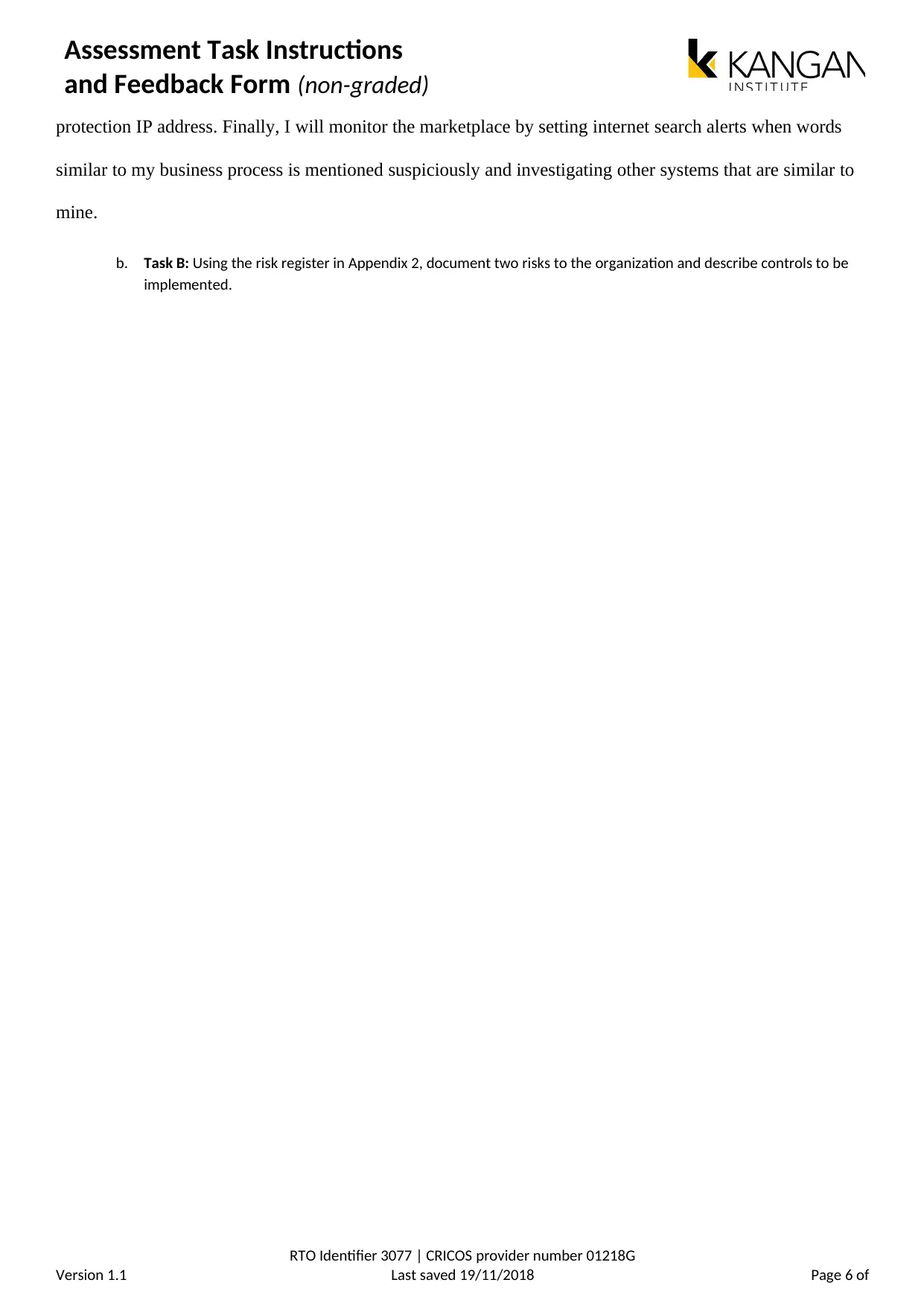
Assessment Task Instructions
and Feedback Form (non-graded)
protection IP address. Finally, I will monitor the marketplace by setting internet search alerts when words
similar to my business process is mentioned suspiciously and investigating other systems that are similar to
mine.
b. Task B: Using the risk register in Appendix 2, document two risks to the organization and describe controls to be
implemented.
RTO Identifier 3077 | CRICOS provider number 01218G
Version 1.1 Last saved 19/11/2018 Page 6 of
and Feedback Form (non-graded)
protection IP address. Finally, I will monitor the marketplace by setting internet search alerts when words
similar to my business process is mentioned suspiciously and investigating other systems that are similar to
mine.
b. Task B: Using the risk register in Appendix 2, document two risks to the organization and describe controls to be
implemented.
RTO Identifier 3077 | CRICOS provider number 01218G
Version 1.1 Last saved 19/11/2018 Page 6 of
⊘ This is a preview!⊘
Do you want full access?
Subscribe today to unlock all pages.

Trusted by 1+ million students worldwide
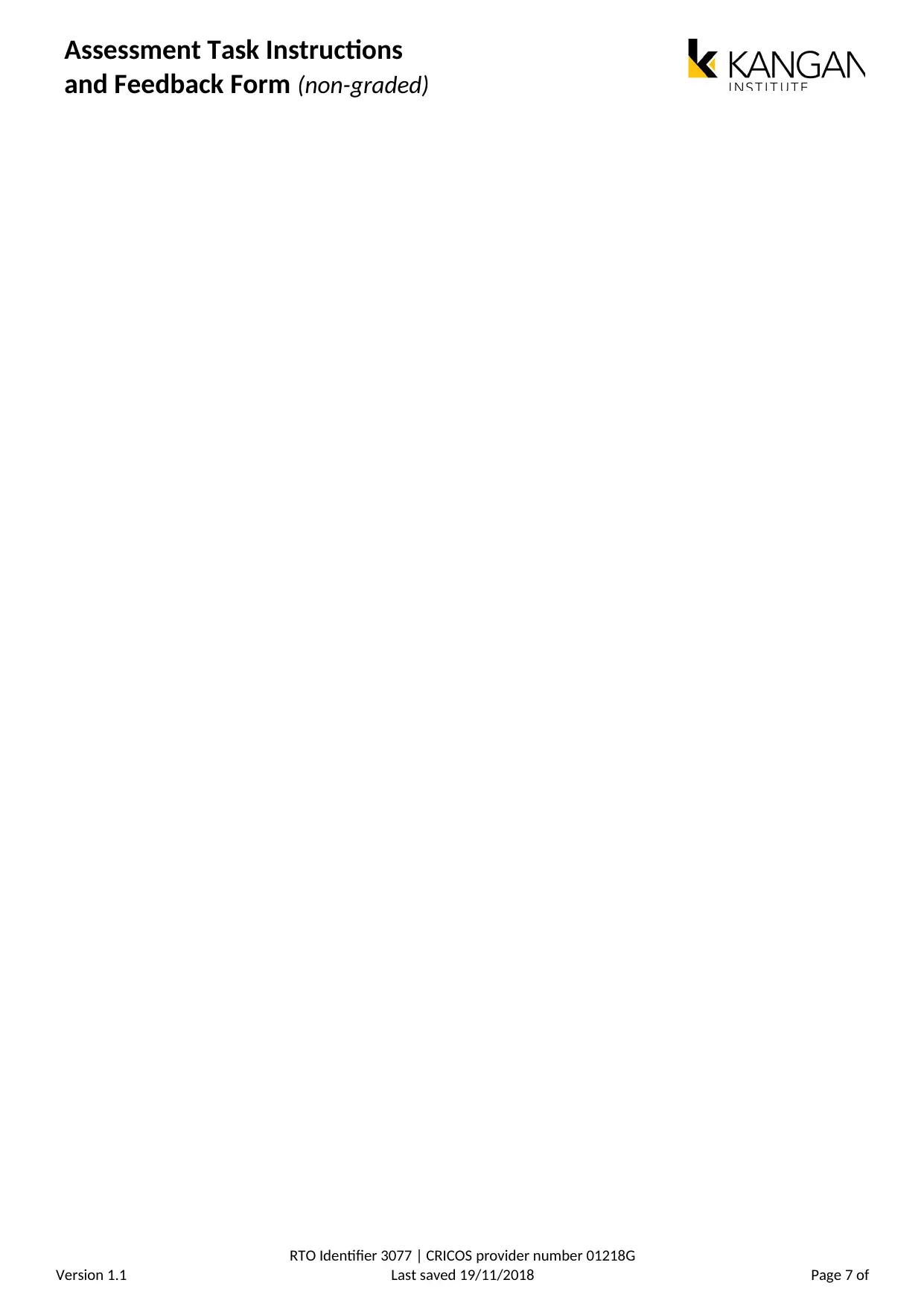
Assessment Task Instructions
and Feedback Form (non-graded)
RTO Identifier 3077 | CRICOS provider number 01218G
Version 1.1 Last saved 19/11/2018 Page 7 of
and Feedback Form (non-graded)
RTO Identifier 3077 | CRICOS provider number 01218G
Version 1.1 Last saved 19/11/2018 Page 7 of
Paraphrase This Document
Need a fresh take? Get an instant paraphrase of this document with our AI Paraphraser

Assessment Task Instructions
and Feedback Form (non-graded)
Appendix 2: Risk register
Intellectual property risk and
description
Likelihoo
d
Impact on
organization
Controls to be implemented
(including summary descriptions of processes, such as
registration, use of databases etc.)
IP infringement by others- the risk is associated
with inappropriate IP protection or explosion of
Ip to unauthorized people.
Very high - It can lead to
additional costs of
recovery
- It can lead to
hacking hence
organization losing
millions of money
- It can display
unauthorized
information to
competitors
- Registration of the patent copyrights and trademark
that ensures the organization is protected from
intruders.
- Making sure only authorized personnel have rights of
accessing databases and other computers with
sensitive information
- Implementation of firewalls for tracking network
traffics
- Implementation of keywords or Google search
engines
The diminish or loss of intellectual property. This
type of risk occurs because of ownership or title
challenges, non-infringement and legal findings
of invalidity.
Medium - Reduction in
product revenues
- License diminishing
- High costs incurred
Insurance- Through insurance of all registered intellectual
properties, it will ensure the risks occurred is not
significantly high.
RTO Identifier 3077 | CRICOS provider number 01218G
Version 1.1 Last saved 19/11/2018 Page 8 of 9
and Feedback Form (non-graded)
Appendix 2: Risk register
Intellectual property risk and
description
Likelihoo
d
Impact on
organization
Controls to be implemented
(including summary descriptions of processes, such as
registration, use of databases etc.)
IP infringement by others- the risk is associated
with inappropriate IP protection or explosion of
Ip to unauthorized people.
Very high - It can lead to
additional costs of
recovery
- It can lead to
hacking hence
organization losing
millions of money
- It can display
unauthorized
information to
competitors
- Registration of the patent copyrights and trademark
that ensures the organization is protected from
intruders.
- Making sure only authorized personnel have rights of
accessing databases and other computers with
sensitive information
- Implementation of firewalls for tracking network
traffics
- Implementation of keywords or Google search
engines
The diminish or loss of intellectual property. This
type of risk occurs because of ownership or title
challenges, non-infringement and legal findings
of invalidity.
Medium - Reduction in
product revenues
- License diminishing
- High costs incurred
Insurance- Through insurance of all registered intellectual
properties, it will ensure the risks occurred is not
significantly high.
RTO Identifier 3077 | CRICOS provider number 01218G
Version 1.1 Last saved 19/11/2018 Page 8 of 9
1 out of 8
Related Documents
Your All-in-One AI-Powered Toolkit for Academic Success.
+13062052269
info@desklib.com
Available 24*7 on WhatsApp / Email
![[object Object]](/_next/static/media/star-bottom.7253800d.svg)
Unlock your academic potential
Copyright © 2020–2025 A2Z Services. All Rights Reserved. Developed and managed by ZUCOL.





